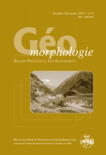
Geomorphologie-Relief Processus Environnement
Scope & Guideline
Advancing Insights into Relief and Environment
Introduction
Aims and Scopes
- Geomorphological Analysis:
The journal prioritizes in-depth studies of landforms and geomorphic processes, utilizing both field investigations and remote sensing techniques. - Environmental Interactions:
Research often explores the impact of environmental factors such as climate change, human activities, and geological processes on geomorphological landscapes. - Interdisciplinary Approaches:
The journal encourages the integration of various scientific disciplines, including archaeology, hydrology, and ecology, to provide a comprehensive understanding of geomorphological phenomena. - Technological Contributions:
Significant emphasis is placed on innovative technologies like LiDAR and GIS in geomorphological research, enhancing the precision and scope of studies. - Socio-Environmental Impacts:
The journal addresses the socio-environmental implications of geomorphological changes, focusing on how these changes affect human activities and natural resources.
Trending and Emerging
- Impact of Climate Change:
A growing body of work is focusing on the spatial impacts of climate change on geomorphological processes, highlighting its relevance in understanding future landscape dynamics. - Technological Innovations in Geomorphology:
The use of cutting-edge technologies such as airborne LiDAR and remote sensing is increasingly prevalent, showcasing the journal's commitment to modernizing geomorphological research. - Anthropogenic Influences on Landscapes:
There is an emerging theme that examines how human activities, including urbanization and land use changes, are affecting geomorphological processes and landscapes. - Geoarchaeology:
Research at the intersection of geomorphology and archaeology is gaining traction, reflecting an interest in understanding how past human activities have shaped contemporary landscapes. - Hydrogeomorphological Interactions:
The exploration of hydrogeomorphological relationships is trending, particularly in relation to sediment transport and river dynamics, emphasizing the importance of water in shaping landforms.
Declining or Waning
- Historical Geomorphological Studies:
While historical analyses of geomorphological changes were once common, recent publications indicate a decrease in this focus, potentially due to a shift towards contemporary and applied geomorphology. - Purely Theoretical Approaches:
There appears to be a waning interest in purely theoretical discussions of geomorphological concepts without empirical data, as the journal increasingly favors studies with tangible fieldwork or case studies. - Geotechnical Studies:
Although geotechnical approaches have been featured, they are becoming less frequent, possibly overshadowed by more integrative studies that combine geomorphology with environmental and ecological aspects.
Similar Journals
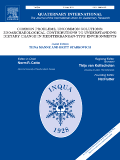
QUATERNARY INTERNATIONAL
Connecting Disciplines Through Quaternary Research.Quaternary International is a prestigious journal published by Pergamon-Elsevier Science Ltd, focusing on the interdisciplinary study of the Quaternary Period, which encompasses significant geological, hydrological, and climatic changes. With an ISSN of 1040-6182 and E-ISSN 1873-4553, it stands as a critical resource in the realm of Earth-Surface Processes, achieving a strong position within the academic community, evidenced by its 2023 Scopus rank of #32 out of 179 in this category, corresponding to an impressive 82nd percentile. Since its inception in 1989, this journal has provided valuable insights and contributed to the advancement of knowledge in the Earth and Planetary Sciences. Researchers, professionals, and students alike will find a wealth of original research articles, reviews, and case studies that inform and inspire further studies in the Quaternary sciences. Although the journal does not currently offer open access options, its reputation for rigorous peer review and impactful content underscores its significance in shaping scholarly discourse in the field.
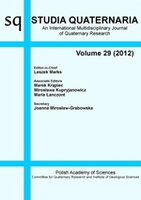
Studia Quaternaria
Illuminating the complexities of our planet's surface.Studia Quaternaria is a leading academic journal published by the Polish Academy of Sciences, Institute of Geological Sciences, specializing in the dynamic fields of Earth-Surface Processes and Geology. With an ISSN of 1641-5558 and an E-ISSN of 2300-0384, this journal has been a prominent platform for scholarly discourse since its inception in 2000. Operating under the open-access model, it aims to disseminate high-quality research that is accessible to a global audience. Studia Quaternaria holds a Q3 ranking in both relevant quartiles as of 2023, indicating its commitment to advancing knowledge in its disciplines despite centering in competitive academic environments. With its publications indexed in Scopus, the journal remains a valuable resource for researchers, professionals, and students looking to stay abreast of innovations and discoveries in Earth-Surface Processes and Geology. Encompassing a broad scope of studies, the journal represents an essential contribution to the geological sciences, fostering a deeper understanding of our planet's changes and processes.

EARTH SURFACE PROCESSES AND LANDFORMS
Exploring the Forces that Shape Our PlanetEARTH SURFACE PROCESSES AND LANDFORMS is a renowned academic journal dedicated to the comprehensive exploration of dynamic processes shaping the Earth's surface. Published by Wiley, this esteemed journal has established itself as a leading platform in the fields of Earth and Planetary Sciences, Geography, Planning, and Development. With an impressive Impact Factor and ranked in the Q1 category for multiple disciplines, it consistently features cutting-edge research that contributes to the understanding of geomorphology, hydrology, and related environmental phenomena. Researchers and professionals can benefit from the journal's extensive repository of high-quality studies, making it a crucial resource for advancing knowledge in these vital areas. As it continues to converge from 1981 to 2024, EARTH SURFACE PROCESSES AND LANDFORMS remains pivotal for scholars aiming to engage in high-level discourse and discovery in Earth sciences.
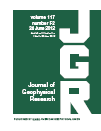
JOURNAL OF GEOPHYSICAL RESEARCH-EARTH SURFACE
Advancing Knowledge in Geophysical Research.JOURNAL OF GEOPHYSICAL RESEARCH-EARTH SURFACE, published by the American Geophysical Union, stands as a leading voice in the fields of Earth-Surface Processes and Geophysics. With an impressive impact factor placing it in the Q1 category for both disciplines, this journal offers invaluable insights and research findings that address critical challenges related to Earth's surface dynamics and processes. Since its inception in 2004, the journal has been dedicated to fostering a deeper understanding and interdisciplinary exploration of topics critical to environmental science, geology, and geophysics. Researchers and professionals in the field will find cutting-edge studies meticulously peer-reviewed to ensure high quality and relevance, making it an essential resource for academics, practitioners, and students alike. The journal's significant Scopus rankings — 25th out of 179 in Earth-Surface Processes and 26th out of 165 in Geophysics — underscore its influence and the rigor of its content, encouraging submission and engagement from leading scholars globally.
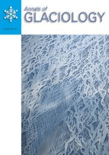
ANNALS OF GLACIOLOGY
Advancing Knowledge in Glaciology and Cryospheric SciencesANNALS OF GLACIOLOGY, published by Cambridge University Press, is a premier open-access journal tailored for the field of glaciology and cryospheric sciences. Established in 1980, the journal has become a vital resource for researchers and professionals analyzing the multifaceted interactions between glaciers, ice sheets, and the Earth's climate system. With a commendable Q1 status in Earth-Surface Processes for 2023 and a commitment to open access since 2016, ANNALS OF GLACIOLOGY provides unparalleled visibility and accessibility for cutting-edge research, fostering global dialogue and innovation among scientists. The journal features a broad scope, encompassing both fundamental studies and applied research on glacial characteristics, behavior, and their environmental impacts. Located in Cambridge, England, this journal is particularly essential for those engaged in the ongoing exploration of our planet's cryospheric changes, their implications, and their relevance to climate science.

Journal of Asian Earth Sciences-X
Exploring the Depths of Asian GeosciencesJournal of Asian Earth Sciences-X, a distinguished publication by ELSEVIER, is at the forefront of Earth and planetary sciences, particularly focusing on the dynamic fields of geology and earth-surface processes. As an Open Access journal since 2019, it provides unparalleled access to high-quality research, fostering global collaboration and dissemination of knowledge. With an impressive impact factor and ranking in the Q2 category for both Earth-Surface Processes and Geology, it serves as a crucial platform for researchers, professionals, and students alike to share their findings and insights. Situated in the United Kingdom, the journal thrives on contributions that enhance our understanding of Asian geosciences within a broader global context, aiming to tackle major challenges such as climate change and natural resource management. By bridging regional studies with global perspectives, the Journal of Asian Earth Sciences-X is not only a vital resource for academia but also supports sustainable development initiatives across the region.

GEOGRAFISKA ANNALER SERIES A-PHYSICAL GEOGRAPHY
Exploring Earth's Dynamics and ProcessesGeografiska Annaler Series A-Physical Geography, published by Taylor & Francis Ltd, is a leading academic journal dedicated to the advancing field of physical geography. With a rich publication history spanning from 1979 to 2024, this journal stands out in its categories, being positioned in the Q2 quartile for both Geography, Planning and Development and Geology in 2023. The journal is recognized for its contribution to Earth and Planetary Sciences, evidenced by its Scopus rankings placing it in the top 31% and 32% of its respective disciplines. Belonging to a distinguished publisher from the United Kingdom, it provides a vital platform for researchers, professionals, and students to disseminate and engage with cutting-edge research. While the journal does not currently offer open access, it remains a pivotal resource for those involved in the study of physical geography, offering insights that enhance our understanding of the Earth's processes and environments.

Czech Polar Reports
Enhancing Understanding of Polar EcosystemsCzech Polar Reports, published by Masaryk University Press, is a pivotal academic journal dedicated to advancing research in the realms of Agricultural and Biological Sciences, Earth and Planetary Sciences, and Environmental Science. Since its inception in 2014, this peer-reviewed journal has established a solid reputation as a medium for disseminating innovative research, particularly in the unique environmental contexts of polar regions. With an impressive Q3 ranking in its designated categories by 2023, Czech Polar Reports serves as a valuable resource for researchers, professionals, and students seeking to deepen their understanding of ecological and climatic changes in these critical areas. While the journal is not fully Open Access, it aims to contribute substantially to ongoing scholarly dialogues and provide insights that are essential for sustainability and climate action. The journal's commitment to fostering interdisciplinary research underscores its importance in a rapidly evolving scientific landscape.

Revista Brasileira de Geomorfologia
Fostering Innovation in Geomorphology ResearchRevista Brasileira de Geomorfologia is a prominent open-access journal dedicated to the field of geomorphology, fostered by the UNIAO GEOMORFOLOGIA BRASILEIRA since its inception in 2000. Based in Brazil, this journal serves as a vital platform for researchers, professionals, and students to disseminate and engage with cutting-edge research on the dynamic processes shaping the Earth's surface. With an ISSN of 1519-1540 and an E-ISSN of 2236-5664, it has earned its place within the academic community, ranking in the Q3 category in the Earth-Surface Processes domain according to the latest 2023 quartiles. The journal's metrics, including a Scopus rank of 123/179 within its category, reflect its commitment to quality research. By facilitating open access to its content, the Revista Brasileira de Geomorfologia not only promotes scholarly communication but also enhances the visibility of vital studies detrimental to understanding geomorphological transformations and environmental change. Join the ongoing discourse and contribute to advancing knowledge in this essential field of Earth sciences.

Cryosphere
Exploring Earth's Frozen FrontiersCryosphere is a leading, peer-reviewed journal dedicated to the study of the Earth's cryospheric processes and their implications on environmental science. Published by COPERNICUS GESELLSCHAFT MBH since 2007, this open-access journal serves as a critical platform for researchers, professionals, and students interested in Earth-Surface Processes and Water Science and Technology. With an impressive impact factor and consistently ranked in the Q1 category for both Earth-Surface Processes and Water Science and Technology, Cryosphere holds a prestigious position in the global research community. The journal's scope encompasses a wide range of topics, from glaciology and snow science to the dynamics of ice bodies and their interactions with climate change. Based in Göttingen, Germany, Cryosphere not only facilitates the dissemination of high-quality research findings but also fosters interdisciplinary collaboration and dialogue among scientists and practitioners worldwide.